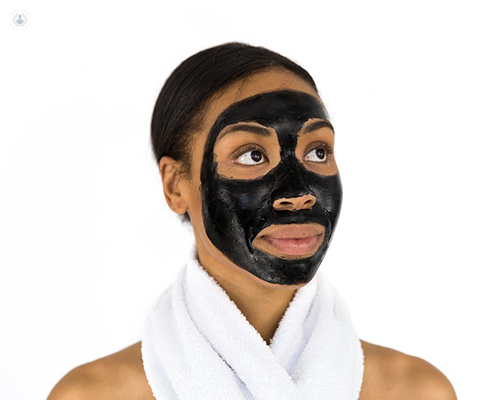Building a skincare routine for acne-prone skin
Written by:If you suffer from acne, it’s a given that you want to know how to get rid of those breakouts and blemishes. However, it can be difficult to know where to start, particularly when there is a great deal of information on the world wide web – more often than not full of seemingly conflicting ideas, product-pushing posts, and skincare routines with more steps than the Great Wall. We asked Dr Firas Al-Niaimi, consultant dermatologist and acne expert at 152 Harley Street, what the basics of building a routine for acne-prone skin should be.

What causes acne?
Acne is a skin condition occurring when the hair follicles in the skin are blocked by dead skin cells and an oily substance called sebum, which normally helps protect the skin. Too much sebum production can lead to acne. It’s not known exactly what causes this, and anyone can get acne – even though it is more common in teenage years. Taking care of your skin in the right way can help to prevent breakouts and stop your acne from getting worse.
Cleanse gently, but cleanse well
The first step in every skincare routine should be a good cleanse, using a wash or exfoliator that helps to reduce oil. Cleansing your skin properly helps to remove the build-up of dirt, oil, and debris, and, if you wear it, make-up. This dirt and debris can, over time, clog pores and cause breakouts to happen. Cleansing can help decongest pores, and helps with excess oil production too. How can you ensure you’re getting the best cleanse?
Focus on getting a cleanser that is able to remove excess dirt and oil, but also doesn’t strip your skin. If your skin is easily irritated or experiences frequent breakouts, choosing the right cleanser is especially important. A low pH or neutral pH cleanser may help with breakouts – healthy skin has an acidic (low) pH, ideally standing at about 5.5. Your skin has a natural acid mantle, secreted by your sebaceous glands, which helps to keep bacteria at bay and stops breakouts from forming. If you use a higher pH cleanser (alkaline), you risk harming the acid mantle, which in turn may encourage the growth of bacteria, meaning breakouts and issues with complexion are more likely. Many cleansers available on the market now advertise their pH, and pharmacies and dermatologists’ offices often carry cleansers specially formulated to be low pH.
A popular method of cleansing is the double cleansing method, which involves using an oil cleanser followed by a foam/gel cleanser.
The first cleanse: oil-based
Using an oil-based cleanser may sound strange to those who struggle with an excess in oil production. However, it's important to remember that like attracts like, so this type of cleanser draws out excess sebum, dirt and makeup gently, without damaging the skin. Oil cleansing is a gentle but effective way of removing make-up. Massage the oil into your skin, leave it to rest for around 30 seconds, then wipe off with a warm washcloth or rinse with warm water.
The second cleanse: foam
While an oil-based cleanser eliminates greasy dirt, a water-based product helps to remove traces of any remaining dirt from the surrounding environment built up in day-to-day life, such as sweat and pollutants. You can use a low-pH cleanser as mentioned before, or find a milk, gel, or other foam-based cleanser based on your needs and what works well with your skin.
The double cleansing method works to remove all make-up and impurities, but take care not to overdo it – it is usually not necessary in the morning as there is no make-up or sun cream to remove. If you have very sensitive skin, you may not need to double cleanse daily. It is important to remember to be gentle with your skin, and not use anything which makes your skin feel tight, inflamed, or sore.
After cleansing: a good quality toner for oily skin
Toners are important in those with oily skin, helping to reduce shine and remove oil build-up. They also help to put moisture back into your skin after cleansing, and help to nourish and soothe the skin through anti-oxidants and hydrating ingredients.
Try to avoid toners which have a high alcohol content, or heavily fragranced toners. Alcohol can dry or aggravate the skin, and fragrance can cause reactions, meaning acne breakouts are more likely to occur.
Another important step: a light, fresh moisturiser that hydrates
Moisturisers can help keep the skin hydrated, which in turn means oil is depleted in the skin. If you have oily skin, moisturiser may sound like the last thing you want, but once the skin is dehydrated or feels slightly dry, it naturally produces more oil to compensate. All skin types need some form of hydration to keep it healthy.
Some moisturisers, however, can be particularly heavy or occlusive, or contain ingredients such as alcohol which can sometimes irritate the skin. Using a light, serum-based moisturiser can help to keep skin adequately hydrated without clogging pores. When skin is healthy and hydrated, it can help to fight bacteria growth and breakouts, and help skin to heal more quickly. Look for water-based moisturisers and hydrators, like serums and gels.
Other tips to help acne-prone skin
1. Try to use oil-free make up.
Acne-prone and oily skin types should try to use oil-free make-up, or make-up labelled non-comedogenic, which clog pores less, reducing the risk of breakout.
2. Exfoliate a couple of times a week.
Build-up of dirt in the pores can be tricky to remove when it is deep. Try to use a gentle method of exfoliation that does not irritate the skin – scrubs with large particles can often damage the skin or prevent existing breakouts from healing. Chemical exfoliation can help to remove dead skin cells and boost cell turnover. There are many products now available, which come in the form of wash-off masks, peeling pads, serums, and even toners.
3. Wear sunscreen
Healthy skin stands less of a chance of developing acne or breaking out. Sun damage can disrupt the surface of the skin, and in the long term can also be the cause of pigmentation and skin cancer. Wear SPF daily on the face to protect the skin.
4. Use a vitamin A cream at night to rejuvenate the skin
Vitamin A comes in various forms, and it is a common treatment for acne. Vitamin A helps to promote skin-building compounds and build collagen fibres, meaning skin renews more quickly and stays healthy.
Acne experienced long-term can seriously affect your self-esteem. If you are worried about your acne, seek advice from a dermatologist, who can advise you best and provide you with an expert opinion.

